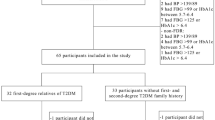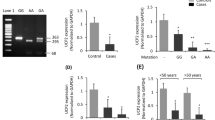Abstract
Background and aims: Some studies have pointed to a role of uncoupling protein 3 (UCP3) in the regulation of fat distribution. The aim of our study was to investigate the influence of −55CT polymorphism of UCP3 gene on fat mass and adipocytokines in naïve patients with Type 2 diabetes mellitus. Design: A population of 57 patients with Type 2 diabetes mellitus and obesity was analyzed in a cross-sectional study. Genotype of UCP3 gene −55CT was studied. Results: Forty-six patients (80.7%) had the 55CC genotype and 11 patients (19.3%) the 55CT genotype. Fat mass (39.1 ±15.4 vs 53.3±16.8 kg; p<0.05), weight (92.6±17.7 vs 106.3±17.3 kg; p<0.05), body mass index (36.2±6.5 vs 42.8±5.2 kg/m2; p<0.05), waist circumference (112.8±13.6 vs 127.9±12.3 cm; p<0.05), waist-to-hip ratio (0.96±0.1 vs 1.1 ±0.2; p<0.05), C reactive protein (6.1 ±5.1 vs 12.4±6.1 mg/dl; p<0.05) and leptin (92.8±86 vs 114±89 ng/ml; p<0.05) were higher in patients with mutant genotype than in those with wild genotype. Conclusion: C reactive protein and fat mass were higher in the mutant group of −55 CT UCP3 gene diabetic patients than in wild type patients.
Similar content being viewed by others
References
Aranceta J, Pérez Rodrigo C, Serra Majem L, et al. Prevalencia de la obesidad en España: estudio SEEDO′97. Med Clin (Barc) 1998, 111: 441–5.
Vidal-Puig A, Solanes G, Grujic D, Flier JS, Lowell BB. UCP3: an uncoupling protein homologue expressed preferentially and abundantly in skeletal muscle and brown adipose tissue. Biochem Biophys Res Commun 1997, 235: 79–82.
Saltzman E, Roberts SB. The role of energy expenditure in energy regulation: findings from a decade research. Nutr Rev 1995, 53: 209–20.
Bouchard C, Pérusse L, Chagnon YC, Warden C, Ricquier D. Linkage between markers in the vicinity of the uncoupling protein 2 gene and resting metabolic rate in humans. Hum Mol Genet 1997, 6: 1887–9.
Clapham JC, Arch JR, Chapman H, et al. Mice overexpressing human uncoupling protein-3 in skeletal muscle are hyperphagic and lean. Nature 2000, 406: 415–8.
Samec S, Seydoux J, Dulloo AG. Role of UCP homologues in skeletal muscle and free fatty acids in obesity. FASEB J 1998, 12: 715–24.
Schrauwen P, Xia Xia J, Walder K, Snitker S, Ravussin E. A novel polymorphism in the proximal UCP3 promoter region: effect on skeletal muscle. UCP3 m RNA expression and obesity in male non-diabetic Pima Indians. Int J Obes Relat Metab Disord 1999, 23: 1242–5.
Otabe S, Clement K, Dina C, et al. A genetic variation in the 5′ flanking region of the UCP3 is associated with body mass index in humans in interaction with physical activity. Diabetologia 2000, 43: 245–9.
Meirhaeghe A, Amoyel P, Helbecque N, et al. An uncoupling protein 3 gene polymorphism associated with a lower risk of developing Type II diabetes and with atherogenic lipid profile in a French cohort. Diabetologia 2000, 43: 1424–8.
Alonso A, Martí A, Corbalán MS, Martínez-González MA, Forga L, Martínez JA. Association of UCP3 gene −55C>T polymorphism and obesity in a Spanish population. Ann Nutr Metab 2005, 49: 183–8.
Matthews DR, Hosker JP, Rudenski AS, Naylor BA, Treacher DF, Turner RC. Homeostasis model assessment: insulin resistance and beta-cell function from fasting plasma glucose and insulin concentrations in man. Diabetologia 1985, 28: 412–4.
Feurer ID, Mullen JL. Bedside measurement of resting energy expenditure and respiratory quotient via indirect calorimetry. Nutr Clin Pract 1986, 1: 43–9.
Pichard C, Slosman D, Hirschel B, Kyle U. Bioimpedance analysis: an improved method for nutritional follow up. Clin Res 1993, 41: 53.
Mataix J, Mañas M. Tablas de composición de alimentos españoles. Granada: Ed Universidad de Granada 2003.
Hesselink MK, Mensink M, Schrauwen P. Human uncoupling protein-3 and obesity: an update. Obes Res 2003, 11: 1429–40.
Cortright RN, Zheng D, Jones JP, et al. Regulation of skeletal muscle UCP2 and UCP3 gene expression by exercise and denervation. Am J Physiol 1999, 276: E217–21.
Dalgaard LT, Sørensen TI, Drivsholm T, et al. A prevalent polymorphism in the promoter of the UCP3 gene and its relationship to body mass index and long term body weight change in the Danish population. J Clin Endocrinol Metab 2001, 86: 1398–402.
Liu YJ, Liu PY, Long J, et al. Linkage and association analyses of the UCP3 gene with obesity phenotypes in Caucasian families. Physiol Genomics 2005, 22: 197–203.
Cassell PG, Saker PJ, Huxtable SJ, et al. Evidence that single nucleotide polymorphism in the uncoupling protein 3 (UCP3) gene influences fat distribution in women of European and Asian origin. Diabetologia 2000, 43: 1558–64.
Lanouette CM, Chagnon YC, Rice T, Perusse L, Muzzin P, Giacobino JP. Uncoupling protein 3 genes is associated with body composition with training in HERITAGE study. J Appl Physiol 2002, 92: 1111–8.
de Luis DA, Aller R, Izaola O, González Sagrado M, Conde R, Pérez Castrillón JL. Lack of association of −55ct polymorphism of UCP3 gene with fat distribution in obese patients. Ann Nutr Metab 2007, 51: 374–8.
Speakman JR, Stubbs RJ, Mercer JG. Does body mass play a role in the regulation of food intake? Proc Nutr Soc 2002, 61: 473–87.
Rudofsky G Jr, Schroedter A, Schlotterer A, et al. Functional polymorphisms of UCP2 and UCP3 are associated with a reduced prevalence of diabetic neuropathy in patients with type 1 diabetes. Diabetes Care 2006, 29: 89–94.
Author information
Authors and Affiliations
Rights and permissions
About this article
Cite this article
de Luis, D.A., Aller, R., Izaola, O. et al. Association of −55CT polymorphism of UCP3 gene with fat distribution, cardiovascular risk factors and adipocytokines in patients with Type 2 diabetes mellitus. J Endocrinol Invest 35, 625–628 (2012). https://doi.org/10.3275/7908
Accepted:
Published:
Issue Date:
DOI: https://doi.org/10.3275/7908




